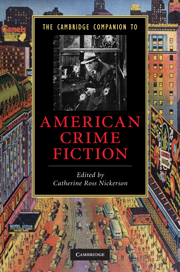Book contents
- Frontmatter
- 1 Introduction: The satisfactions of murder
- 2 Early American crime writing
- 3 Poe and the origins of detective fiction
- 4 Women writers before 1960
- 5 The hard-boiled novel
- 6 The American roman noir
- 7 Teenage detectives and teenage delinquents
- 8 American spy fiction
- 9 The police procedural in literature and on television
- 10 Mafia stories and the American gangster
- 11 True crime
- 12 Race and American crime fiction
- 13 Feminist crime fiction
- 14 Crime in postmodernist fiction
- Guide to reading
- Index
6 - The American roman noir
Published online by Cambridge University Press: 28 September 2010
- Frontmatter
- 1 Introduction: The satisfactions of murder
- 2 Early American crime writing
- 3 Poe and the origins of detective fiction
- 4 Women writers before 1960
- 5 The hard-boiled novel
- 6 The American roman noir
- 7 Teenage detectives and teenage delinquents
- 8 American spy fiction
- 9 The police procedural in literature and on television
- 10 Mafia stories and the American gangster
- 11 True crime
- 12 Race and American crime fiction
- 13 Feminist crime fiction
- 14 Crime in postmodernist fiction
- Guide to reading
- Index
Summary
There is an infamous moment in Dashiell Hammett's 1929 novel Red Harvest where his detective, the Continental Op, wakes up bleary-eyed from a laudanum-induced slumber to find his right hand wrapped around “the blue and white handle” of an ice pick whose “needle-sharp blade” has been “buried in Dinah Brand's left breast.” Its significance lies not in the fact that Brand has been murdered but rather for the way in which it seems to implicate Hammett's detective in the act itself. Just as revealing is the Op's inability to discount himself as a suspect, at least until the end of the novel when his innocence is finally confirmed. Red Harvest is often cited as the first hardboiled American crime novel, but the fact that it might also constitute the first American roman noir draws attention to the close relationship between what we might tentatively call these different subgenres of crime writing. In the end, the Op's investigative prowess brings order, and the law, to the western US city of Personville and, as such, it might be premature to argue for its classification as a noir novel (as opposed to a hard-boiled detective novel), but in other ways the similarities between Red Harvest and works by writers such as Horace McCoy, James M. Cain, David Goodis and Jim Thompson are beyond refutation. Before Cain's The Postman Always Rings Twice (1934) and even Paul Cain's Fast One (1932), Hammett deployed many of the traits or features that would later be cited as characteristic of a “noir” sensibility: an unknowable, morally compromised protagonist who is implicated in the sordid world he inhabits, an overwhelming sense of fatalism and bleakness, and a socio-political critique that yields nothing and goes nowhere.
- Type
- Chapter
- Information
- The Cambridge Companion to American Crime Fiction , pp. 58 - 71Publisher: Cambridge University PressPrint publication year: 2010
- 6
- Cited by



